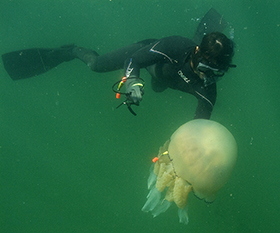Bloomin’ heck! Deakin marine scientist latches onto solution to jellyfish
Media releaseThey can wipe out an entire commercial fish farm overnight, terrify open water swimmers throughout the world and disable power stations, but Deakin University's top marine scientist is part of a global team which could have the solution to the sting of the jellyfish bloom.
In a discovery that could save millions of dollars for the aquaculture and other industries, Marine Science Chair and Alfred Deakin Professor Graeme Hays and colleagues at the UK's Swansea University have discovered jellyfish have a remarkable ability to detect the direction of ocean currents and swim strongly against them.
The researchers tracked the movements of free-ranging barrel-jellyfish with GPS loggers and used GPS-tracked floats to record the current flows in waters off the coast of northern France, finding the creatures, who don't have an actual brain or heart, can do what birds and turtles can't.
They also observed the swimming direction of large numbers of jellyfish at the surface of the ocean, with the GPS data showing jellyfish can actively swim at counter-current in response to drift.
"The insights into their behaviour and the movements of the ocean helps to explain how jellyfish can form blooms including hundreds to millions of individuals for periods up to several months," Professor Hays, a member of the Centre for Integrative Ecology and School of Life and Environmental Sciences, said.
The research, "Current-oriented swimming by jellyfish and its role in bloom maintenance", has been published this month in Current Biology.
Professor Hays is now working with Griffith University researchers in Queensland to see if the findings are replicated across other species of jellyfish.
"Is this superpower applicable to all species of jellyfish or is it just some species?" he said was the key question scientists now needed to know.
"If they are, this will be terribly exciting and means we can solve a universal problem."
It is also not yet clear exactly how the jellyfish figure out which way to go, but Professor Hays said it was possible the animals detected current shear across their body surface, or they could indirectly assess the direction of drift using other cues, such as the Earth's magnetic field or infrasound.
"Understanding the distribution of jellyfish in the open ocean may be practically useful for predicting and avoiding troublesome jellyfish blooms and, for example, aquaculture farms can use that information to protect their fish.
"They can do this by building jellyfish boxes around their farms, sealing them in for the period of time the jellyfish blooms are passing through.
"While jellyfish do play an important role in ocean ecosystems as prey for leatherback sea turtles and other animals, they can also clog fishing nets and sting beachgoers."
Professor Hays also has plans to replicate his work in Tasmania, where salmon farms regularly suffer the effects of the jellyfish sting.
"We now know that jellyfish are not just bags of jelly drifting passively in the oceans," he said.
"They are incredibly advanced in their orientation abilities."
Click here for video footage of wild Rhizostoma jellyfish in coastal waters of France tagged with GPS for the research project.
Share this story
 Tagged: Gower Coast Adventures capture a researcher tagging a jellyfish with a GPS off the coast of France.
Tagged: Gower Coast Adventures capture a researcher tagging a jellyfish with a GPS off the coast of France.
